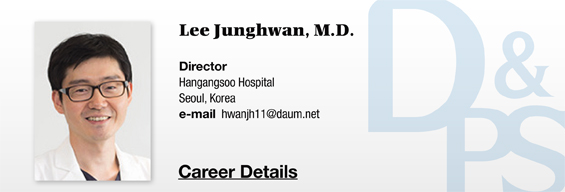

Erythematous Scar
If the scar is reddish in color, vascular Laser such as PDL is primarily considered. Erythematous and hypertrophic scar often develops about a year after trauma. If the erythematous and hypertrophic scar is relatively flat, PDL is used alone. However, if the erythematous and hypertrophic scar is protruding or is accompanied with contracture, PDL is combined with fractional Laser.
In most cases, PDL is used at a low fluence with a 1-2 month interval (4.0 to 5.5 J/cm2, 10mm spot size or 7.0 to 8.0 J/cm2, 7-mm spot size, short pulse width of 0.45 or 1.50 milliseconds).
Hypertrophic Scar
After selecting the primary Laser for removing erythematous scar, consider combining fractional Laser based on the thickness and degree of contracture. When it comes to the fractional Laser, two important choices need to be made; first between AFL and NAFL, and second, between carbon dioxide (CO2) and Er:YAG.
As there is little data compairng AFL and NAFL or CO2 and Er:YAG in scar removal, it is not easy to make the choice. However, based on early literature and clinical experiences, AFL seems to induce stronger remodeling than NAFL.2.3
Recently developed AFLs infiltrate to the depth of 4.0mm, much deeper than the 1.8mm depth of NAFLs, and allows revision of deeper scars. Therefore, in thick scars with limited mobility, AFL may be more effective. In particular, the tissue ablation caused by AFL leads to immediate photomechanical improvement of mobility.
AFLs form ablated columns to remodel scar tissues. The CO2 Laser has lower water absorption than ER:YAG. Therefore, the CO2 Laser may ablate scar tissues more effectively than the Er:YAG Laser. Moreover, the CO2 Laser has a lower risk of bleeding.
What is the most ideal pulse energy settings (treatment depth) in scar revision? The best way is to decide that is to palpate the scar. Palpation helps assess flexibility and thickness of the scar and determine the right pulse energy. It is important to avoid penetrating the scar with too much energy. This requires much trial and error and experience and is one of the biggest challenges of scar treatments. Quantitative analysis using ultrasound could be helpful.
For safety, avoid excessive thermal damage. Use low densities, narrow beam diameter, short pulse width, and the fewest passes possible. If a high pulse energy is needed, lower the density to minimize complications.
It is advised to maintain an interval of 2-3 months between treatments, but I experienced that 4 weeks is sufficient to avoid complications. I perform 3-6 treatments in total and can be extended if the response is good. The end point is loss of response or patient-perceived full resolution.
[Advertisement] A-One LITE(Facial Diagnosys System) – Manufacturer: BOMTECH(www.bomtech.net)
Flat or Atrophic Scar
Atrophic scar occurs due to deficient collagenesis after trauma or dermal indentation (acne scar). The treatment goal for atrophic scar is induction of neocollagenesis for scar remodeling. Neocollagenesis is most effectively induced with fractional Laser.4.5 Relatively thin atrophic scars can show response to NAFL just as well as to AF. NAFL is less painful and causes shorter downtime but higher frequency of treatment is needed to bring outcome similar to that of AFLs.
References
1. R. Rox Anderson, Matthias B. Donelan, Laser Treatment of Traumatic ScarsWith an Emphasis on Ablative Fractional Laser Resurfacing Consensus Report, JAMA Dermatol, 2014;150(2); 187-193
2. Oh BH, Hwang YJ, Lee YW, Choe YB, Ahn KJ. Skin characteristics after fractional photothermolysis. Ann Dermatol. 2011;23(4):448-454.
3. Kim HS, Lee JH, Park YM, Lee JY. Comparison of the effectiveness of nonablative fractional Laser versus ablative fractional Laser in thyroidectomy scar prevention: a pilot study. J Cosmet Laser Ther. 2012;14(2):89-93.
4. OngMW, Bashir SJ. Fractional Laser resurfacing for acne scars: a review. Br J Dermatol. 2012;166(6):1160-1169.
5. Weiss ET, Chapas A, Brightman L, et al. Successful treatment of atrophic postoperative and traumatic scarring with carbon dioxide ablative fractional resurfacing: quantitative volumetric scar improvement. Arch Dermatol. 2010;146(2):133-140.
-To be continued




















